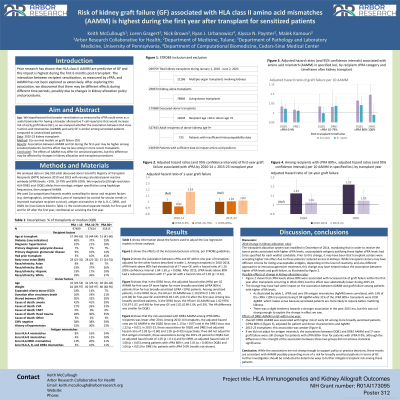Back

(P312) Risk of kidney graft failure (GF) associated with HLA class II amino acid mismatches (AAMM) is highest during the first year after transplant for sensitized patients
Location: Platinum Ballroom

Poster Presenter(s)
Aim: Prior research has shown that HLA class II AAMM are predictive of GF and this impact is highest during the first 6 months post-transplant. We hypothesize that broader sensitization as measured by CPRA could serve as a useful biomarker for having a broader alloreactive T-cell repertoire that would increase risk of early graft failure, so we analyzed whether the association between AAMM and early GF is similar among sensitized patients compared to unsensitized patients.
Method: We analyzed 2010-2023 adult deceased-donor transplant data for 31815 more broadly sensitized recipients (calculated panel reactive antibody (cPRA) 80%+) and 97489 less broadly sensitized recipients (cPRA < 10%). We imputed (x10) high resolution HLA-DRB1 and -DQB1 alleles from serologic antigen specificities using haplotype frequencies, then assigned AAMM.
We used Cox proportional hazards models controlling for donor and recipient factors (e.g. demographics, comorbidities) and antigen mismatches in the A, B, C, DRB1, and DQB1 loci. We constructed separate models for first-year GF and for GF after the first year, conditional on surviving the first year.
Results: In the DRB1 locus, the adjusted hazard ratios (HRs) per 10 AAMM for first-year GF were higher for more broadly sensitized (cPRA 80%+) patients than for less broadly sensitized (cPRA <10%) patients.
Among sensitized patients, in the DRB1 locus, the HR per 10 AAMM was 1.10 (95% CI 1.00-1.20, p=0.04) for first-year GF and 0.99 (0.94-1.05, p=0.71) after the first year. Among less broadly sensitized patients, in the DRB1 locus, the HR per 10 AAMM was 1.02 (95% CI 0.97-1.07, p=0.48) for first-year GF and 1.01 (0.99-1.04, p=0.39). The HR difference was smaller for DQB1 (figure).
Conclusion: We saw a stronger association between DRB1 AAMM and the incremental (adjusted for HLA antigen mismatches) risk of early GF among more broadly sensitized patients despite the fact that transplant centers may have criteria for listing unacceptable antigens, depending on the level of reactivity, and also different approaches to immunosuppressive treatment. While the associations are not strong enough to support policy or practice decisions, these results are consistent with the fact that more broadly sensitized patients can be at increased risk of GF, and this risk may be exacerbated by AAMM.
Method: We analyzed 2010-2023 adult deceased-donor transplant data for 31815 more broadly sensitized recipients (calculated panel reactive antibody (cPRA) 80%+) and 97489 less broadly sensitized recipients (cPRA < 10%). We imputed (x10) high resolution HLA-DRB1 and -DQB1 alleles from serologic antigen specificities using haplotype frequencies, then assigned AAMM.
We used Cox proportional hazards models controlling for donor and recipient factors (e.g. demographics, comorbidities) and antigen mismatches in the A, B, C, DRB1, and DQB1 loci. We constructed separate models for first-year GF and for GF after the first year, conditional on surviving the first year.
Results: In the DRB1 locus, the adjusted hazard ratios (HRs) per 10 AAMM for first-year GF were higher for more broadly sensitized (cPRA 80%+) patients than for less broadly sensitized (cPRA <10%) patients.
Among sensitized patients, in the DRB1 locus, the HR per 10 AAMM was 1.10 (95% CI 1.00-1.20, p=0.04) for first-year GF and 0.99 (0.94-1.05, p=0.71) after the first year. Among less broadly sensitized patients, in the DRB1 locus, the HR per 10 AAMM was 1.02 (95% CI 0.97-1.07, p=0.48) for first-year GF and 1.01 (0.99-1.04, p=0.39). The HR difference was smaller for DQB1 (figure).
Conclusion: We saw a stronger association between DRB1 AAMM and the incremental (adjusted for HLA antigen mismatches) risk of early GF among more broadly sensitized patients despite the fact that transplant centers may have criteria for listing unacceptable antigens, depending on the level of reactivity, and also different approaches to immunosuppressive treatment. While the associations are not strong enough to support policy or practice decisions, these results are consistent with the fact that more broadly sensitized patients can be at increased risk of GF, and this risk may be exacerbated by AAMM.

